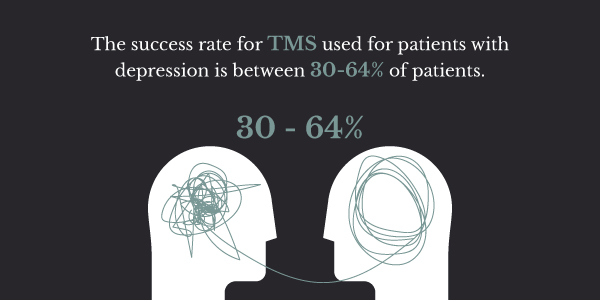How Long Do the Effects of TMS Treatment Last?
What Is TMS Treatment?
Transcranial magnetic stimulation (TMS) is a newer, noninvasive procedure that uses magnetic fields to stimulate nerve cells in the brain in order to help with symptoms of depression. TMS is also known as repetitive transcranial magnetic stimulation (rTMS), due to the fact that it often involves delivering repeated and multiple magnetic pulses. TMS therapy is often utilized for patients who have tried other treatment options to help with their depression that ultimately was not effective in mitigating symptoms. 1

Contact Profound Treatment to Learn More
Our team is standing by to discuss treatment options with you. Your call is completely confidential and no obligation is required.
How Does TMS Therapy Work?
Transcranial Magnetic Stimulation: an Overview
How Can a Magnet Affect My Brain?
What Devices Are Used in TMS?

Surface TMS
Deep TMS
Rapid TMS
How Does TMS Help When Antidepressants Didn’t?
How does TMS therapy work when antidepressants didn’t? Is there that much of a difference in how they affect the regions of the brain associated with depression and mood? TMS treatment tends to work for some patients because it directly affects the electrically charged areas of the brain, whereas antidepressants only focus on brain chemistry in general. Attempting to figure out what symptoms need to be treated, and then finding the right antidepressant for effective treatment, can be difficult and time-consuming depending on the patient and their needs. TMS therapy works in a more direct way than antidepressants do, often helping with symptoms quicker and with more efficacy.7
Side Effects of Antidepressants
Potential Impact(s) of Antidepressants
- Sexual dysfunction
- Weight gain
- Nausea
- Headache
- Irritability
- Blurred vision
- Dry mouth
- Sleep disturbances or fatigue
TMS Therapy to Mitigate Symptoms of Depression
Benefits of Transcranial Magnetic Stimulation
There are multiple benefits of TMS or rTMS for patients who have symptoms of depression, anxiety, OCD, or other mental conditions. These will be detailed below.

Non-Invasive
No Extreme Side Effects
As mentioned briefly above, TMS healing therapy does not have as many side effects as traditional antidepressants can have. This is part of the reason why TMS effectiveness is so high. The most common side effects of TMS are headaches and slight scalp discomfort. Some serious, but very rare, side effects can potentially include seizures or hearing loss. However, a physical examination of the patient will be conducted before therapy starts, helping to mitigate these rarer risk factors.
No Sedation or Anesthesia
Not Addictive
Effective and Has Long-Term Results
Effects of Transcranial Magnetic Stimulation
Short-Term Effects of TMS Therapy
Long-Term Effects of TMS Therapy
How Many TMS Sessions Are Needed?
How Long Does It Take For TMS to Start Working?
How long it takes for patients to see the effects of TMS therapy varies as well, but many patients start to see results within a couple of weeks of starting TMS therapy. Oftentimes, if TMS is administered at least once per day, patients can see results as early as the end of the first week.
How Long Do The Effects of TMS Treatment Last?

Age
Early Positive Responses to TMS Treatments
Severity of Depression
How Many Times Can You Get TMS Treatment?
What Outcomes Should Be Expected From TMS Treatment?
Does Insurance Cover TMS Treatment?

Resources
- 1https://www.mayoclinic.org/tests-procedures/transcranial-magnetic-stimulation/about/pac-20384625#:~:text=
- 2https://my.clevelandclinic.org/health/treatments/17827-transcranial-magnetic-stimulation-tms
- 3https://neuromodec.org/what-is-transcranial-magnetic-stimulation-tms/tms-devices.html
- 4https://www.tmsbrainhealth.com/which-type-of-tms-is-best-comparing-deep-rtms-vs-rtms-vs-neurostar/
- 5https://www.ncbi.nlm.nih.gov/pmc/articles/PMC551158/
- 6
https://www.healthline.com/health/tms-therapy#candidates
- 7
pulsetms.com/blog/how-tms-helps-antidepressants/
- 8
https://www.nhs.uk/mental-health/talking-therapies-medicine-treatments/medicines-and-psychiatry/ssri-antidepressants/overview/
- 9
https://www.health.harvard.edu/blog/transcranial-magnetic-stimulation-for-depression-2018022313335
- 10
https://pubmed.ncbi.nlm.nih.gov/15806046/
- 11
https://www.ncbi.nlm.nih.gov/pmc/articles/PMC5775741/ - 12
https://www.ncbi.nlm.nih.gov/pmc/articles/PMC4473489/







